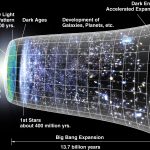Glossary of Radio Astronomy Terms
Balmer lines:
Emission lines in the spectrum of hydrogen that arise from transitions between the second and higher energy states of the hydrogen atom. They were discovered by Swiss physicist J. J. Balmer.

Balmer, J.J.:
A Swiss mathematician and mathematical physicist known for creating the equation that computes the wavelength of a hydrogen atom’s visible spectral lines.

Bandwidth:
The range of frequencies, or wavelengths, that can be detected by a radio telescope or other radio receiver. The greater the bandwidth, the more information astronomers can discover about a distant cosmic object.
Barred Spiral Galaxy:
A variety of a classic spiral galaxy in which the sweeping spiral arms extend from a “bar” that runs through the center of the galaxy. Recent observations suggest that the Milky Way galaxy may be a barred spiral.

Baryon:
A subatomic particle made up of quarks, such as a proton or a neutron.

Baryonic matter:
Matter that is composed mostly of Baryons. All atoms are considered baryonic matter. Other types of matter include ghostly neutrino particles, free electrons, and – perhaps – the elusive particles that make up dark matter.

Baseline:
The distance between two antennas that work together to make astronomical observations. The longer the baseline, the greater the resolution – or ability to detect fine details. For example, in the Very Long Baseline Array the baseline between its easternmost antenna in St. Croix and westernmost antenna in Hawaii is nearly 5,000 miles. The maximum current baseline of the ALMA telescope is approximately 15 kilometers (10 miles).
Beam width:
The size of the point on the sky – measured as an angle – that a radio telescope can see at any given moment. A smaller the beam width, the finer the detail the telescope is observing.
Big Bang:
The well-supported theory that some 13.8 billion years ago, the entire universe was staggeringly small, hot, and dense. In a fraction of an instant, the universe expanded and continues to expand to this day.

Binary:
Two stars in the same system that orbit around a common center of mass due to their mutual gravity. Binary stars are twins in the sense that they formed together out of the same interstellar cloud. Most stars in our galaxy have a binary companion.

Black dwarf:
One possible final stage in the evolution of a star, in which all the energy is exhausted and it no longer emits radiation. The timescale to create such a star, however, is greater than the current age of the universe.
Black Hole:
An object – typically a collapsed star – whose gravity is so strong that its escape velocity exceeds the speed of light.
See more here;
Blazar or BL Lac Object:
Objects that resemble quasars; thought to be the cores of highly luminous galaxies aligned so they are viewed directly down into the heart of the system.

Blue shift:
The apparent shorting in wavelength of light emitted by an object as seen by an observer when the source and observer are moving closer together. See Doppler shift.

Brown Dwarf:
A semi-stellar object made up mostly of hydrogen that straddles the line between a massive Jupiter-like planet and a low-mass red dwarf star. A brown dwarf, however, has insufficient mass to sustain nuclear fusion.







